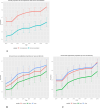Spatial and temporal analysis of HIV clinical outcomes in Florida reveals counties with persistent racial and ethnic disparities during 2012-2019
- PMID: 38459461
- PMCID: PMC10924316
- DOI: 10.1186/s12889-024-17944-w
Spatial and temporal analysis of HIV clinical outcomes in Florida reveals counties with persistent racial and ethnic disparities during 2012-2019
Abstract
Background: Racial/ethnic disparities in the HIV care continuum have been well documented in the US, with especially striking inequalities in viral suppression rates between White and Black persons with HIV (PWH). The South is considered an epicenter of the HIV epidemic in the US, with the largest population of PWH living in Florida. It is unclear whether any disparities in viral suppression or immune reconstitution-a clinical outcome highly correlated with overall prognosis-have changed over time or are homogenous geographically. In this analysis, we 1) investigate longitudinal trends in viral suppression and immune reconstitution among PWH in Florida, 2) examine the impact of socio-ecological factors on the association between race/ethnicity and clinical outcomes, 3) explore spatial and temporal variations in disparities in clinical outcomes.
Methods: Data were obtained from the Florida Department of Health for 42,369 PWH enrolled in the Ryan White program during 2008-2020. We linked the data to county-level socio-ecological variables available from County Health Rankings. GEE models were fit to assess the effect of race/ethnicity on immune reconstitution and viral suppression longitudinally. Poisson Bayesian hierarchical models were fit to analyze geographic variations in racial/ethnic disparities while adjusting for socio-ecological factors.
Results: Proportions of PWH who experienced viral suppression and immune reconstitution rose by 60% and 45%, respectively, from 2008-2020. Odds of immune reconstitution and viral suppression were significantly higher among White [odds ratio =2.34, 95% credible interval=2.14-2.56; 1.95 (1.85-2.05)], and Hispanic [1.70 (1.54-1.87); 2.18(2.07-2.31)] PWH, compared with Black PWH. These findings remained unchanged after accounting for socio-ecological factors. Rural and urban counties in north-central Florida saw the largest racial/ethnic disparities.
Conclusions: There is persistent, spatially heterogeneous, racial/ethnic disparity in HIV clinical outcomes in Florida. This disparity could not be explained by socio-ecological factors, suggesting that further research on modifiable factors that can improve HIV outcomes among Black and Hispanic PWH in Florida is needed.
Keywords: Clinical outcomes; HIV; HIV in the South; Racial disparities; Spatial-temporal epidemiology.
© 2024. The Author(s).
Conflict of interest statement
Liu and Prosperi receive research grant funding from Merck through Merck Investigator Studies Program. No potential conflict of interest was reported by other authors.
Figures


Similar articles
-
The role of race and ethnicity in the State Children's Health Insurance Program (SCHIP) in four states: are there baseline disparities, and what do they mean for SCHIP?Pediatrics. 2003 Dec;112(6 Pt 2):e521. Pediatrics. 2003. PMID: 14654674
-
Understanding Cross-Sectional Racial, Ethnic, and Gender Disparities in Antiretroviral Use and Viral Suppression Among HIV Patients in the United States.Medicine (Baltimore). 2016 Mar;95(13):e3171. doi: 10.1097/MD.0000000000003171. Medicine (Baltimore). 2016. PMID: 27043679 Free PMC article.
-
Place Visitation Data Reveals the Geographic and Racial Disparities of COVID-19 Impact on HIV Service Utilization in the Deep South.AIDS Behav. 2024 Oct;28(Suppl 1):47-60. doi: 10.1007/s10461-023-04163-4. Epub 2023 Oct 4. AIDS Behav. 2024. PMID: 37792234
-
Mortality Disparities in Racial/Ethnic Minority Groups in the Veterans Health Administration: An Evidence Review and Map.Am J Public Health. 2018 Mar;108(3):e1-e11. doi: 10.2105/AJPH.2017.304246. Am J Public Health. 2018. PMID: 29412713 Free PMC article. Review.
-
Impact of Social Determinants of Health on Cancer Treatment Referrals in Patients Living with HIV in the United States: A Narrative Review.J Cancer Policy. 2025 Mar;43:100555. doi: 10.1016/j.jcpo.2024.100555. Epub 2024 Dec 31. J Cancer Policy. 2025. PMID: 39746608 Review.
Cited by
-
Who could benefit the most from long-acting antiretroviral therapy? perspectives of HIV care providers and people with HIV in Florida.AIDS Care. 2025 Jul;37(7):1150-1159. doi: 10.1080/09540121.2025.2510915. Epub 2025 May 28. AIDS Care. 2025. PMID: 40437689
-
Skin Color Representation in Infectious Disease Textbooks.Open Forum Infect Dis. 2024 Nov 26;11(12):ofae703. doi: 10.1093/ofid/ofae703. eCollection 2024 Dec. Open Forum Infect Dis. 2024. PMID: 39679348 Free PMC article.
-
Modeling the Mediating Effects of HIV-Related Stigma on the Associations Between Race/Ethnicity and Antiretroviral Therapy Adherence and Viral Suppression Among Diverse Racial and Ethnic Minority Women with HIV.AIDS Behav. 2025 Aug;29(8):2530-2541. doi: 10.1007/s10461-025-04713-y. Epub 2025 Apr 22. AIDS Behav. 2025. PMID: 40261539
-
HIV knowledge and reported stigma among South Florida health fair participants.PLoS One. 2025 Aug 19;20(8):e0329665. doi: 10.1371/journal.pone.0329665. eCollection 2025. PLoS One. 2025. PMID: 40828797 Free PMC article.
References
-
- Local Data: Florida. https://aidsvu.org/local-data/united-states/south/florida/.
-
- Centers of Disease Control and Prevention: Ending the HIV Epidemic in the U.S. (EHE). In.; 2021.
-
- Yombi JC, Mertes H. Treatment as Prevention for HIV Infection: Current Data, Challenges, and Global Perspectives. AIDS Rev. 2018;20(3):131–140. - PubMed
-
- HIV Data Center: HIV Care Data. http://www.floridahealth.gov/diseases-and-conditions/aids/surveillance/i....
Publication types
MeSH terms
Grants and funding
LinkOut - more resources
Full Text Sources
Medical

